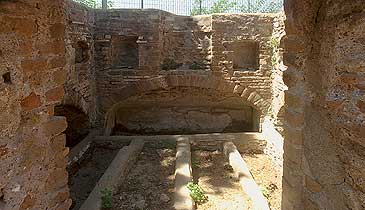When inhumation was introduced,
at first small modifications in the columbarium appeared.
The walls, at floor level, obtained recesses for burials. Most
of these recesses are arc-shaped and called arcosolia.
Later on, small niches were replaced by arcosolia and in
new tombs the number of arcosolia increased. After the early third
century AD new tombs were designed for inhumation only. Because
arcosolia are uneconomic in space, soon the area underneath the
floor was also used.  The
floor was divided by brick walls into a series of graves, The
floor was divided by brick walls into a series of graves,
called formae, sometimes one
row on top of another.
The style of decoration too changed. There was more space to
decorate, and scenes of hunting, wgardens with cupids and so on
became common.
The kind of inhumation too depended on the wealth of the family.
Many bodies were laid in a plain terracotta sarcophagus. Those
who could afford it were laid in a sarcophagus made of marble,
simple or elaborated. The majority were laid in the arcosolia
or formae without a sarcophagus. The arcosolium itself was closed
by a rough wall, sometimes plastered, imitating marble, or by
a marble slab. The latter are plain or decorated. Formae were
often covered by the mosaic or marble floor of the burial chamber.
|